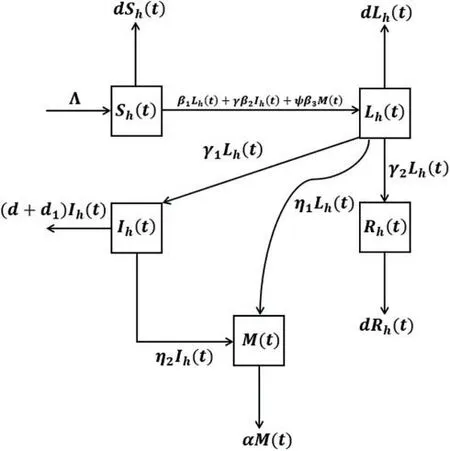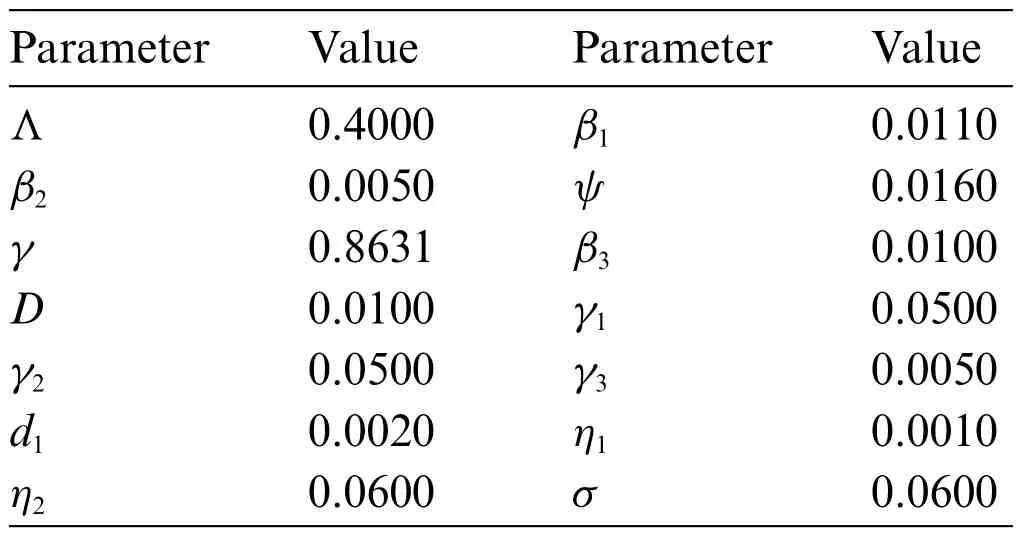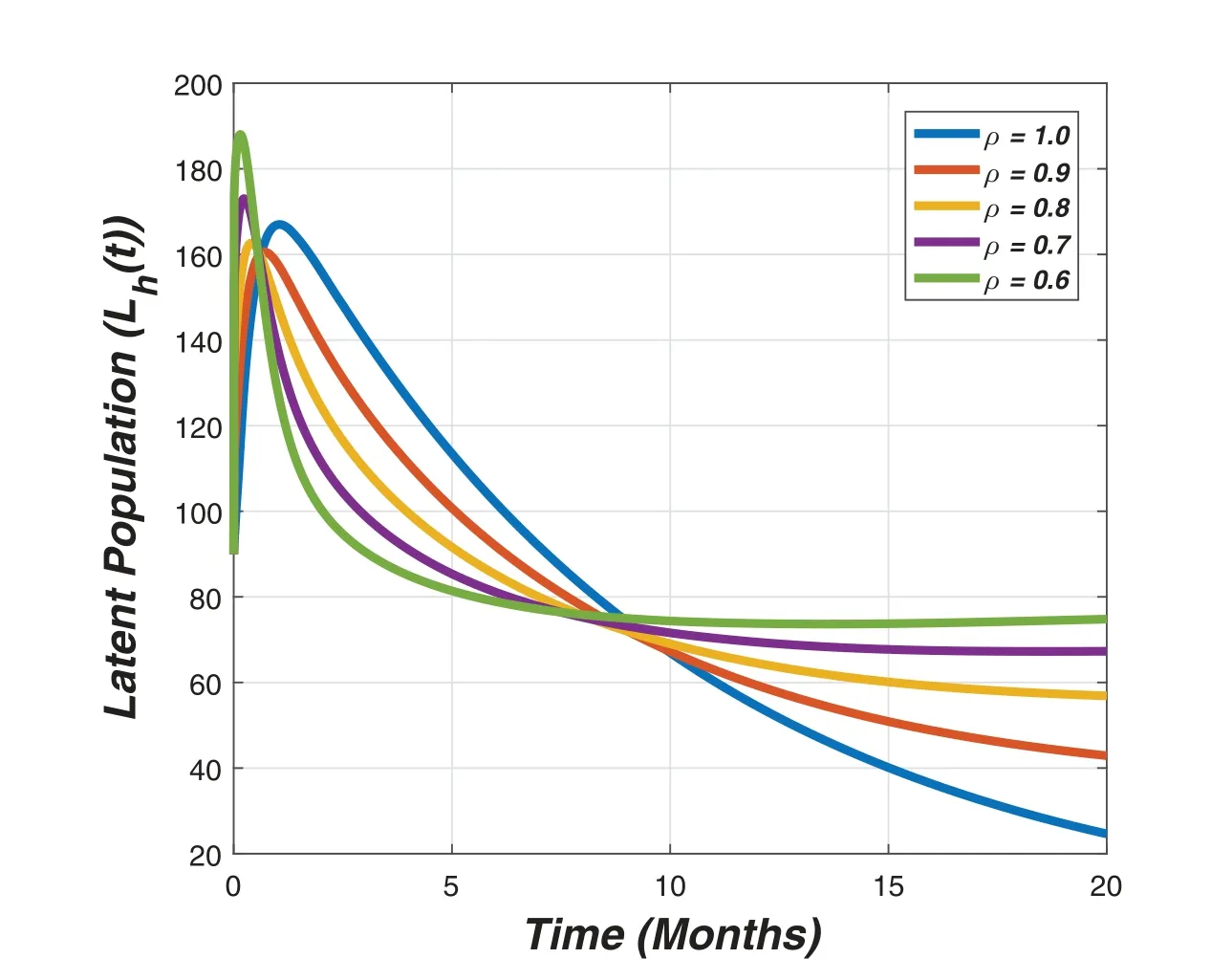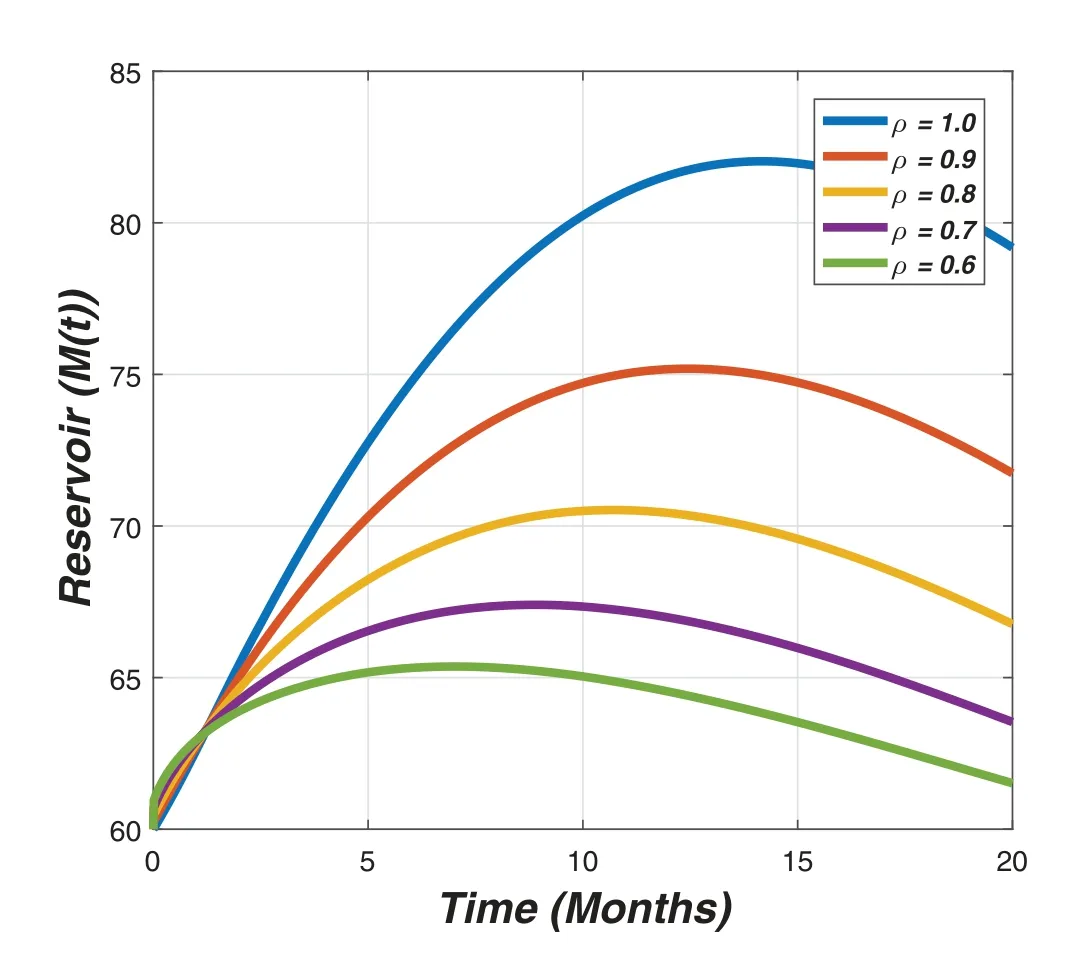A Theoretical Investigation of the SARS-CoV-2 Model via Fractional Order Epidemiological Model
Tahir Khan,Rahman Ullah,Thabet Abdeljawad,Manar A.Alqudah and Faizullah Faiz
1Department of Mathematics and Statistics,Woman University,Swabi,Khyber Pakhtunkhwa,23501,Pakistan
2Department of Mathematics and Sciences,Prince Sultan University,Riyadh,11586,Saudi Arabia
3Department of Medical Research,China Medical University,Taichung,40402,Taiwan
4Department of Mathematical Sciences,Faculty of Sciences,Princess Nourah Bint Abdulrahman University,P.O.Box 84428,Riyadh,11671,Saudi Arabia
5Department of Basic Sciences and Humanities,College of Electrical and Mechanical Engineering,National University of Sciences and Technology(NUST),Islamabad,44320,Pakistan
ABSTRACT We propose a theoretical study investigating the spread of the novel coronavirus(COVID-19)reported in Wuhan City of China in 2019.We develop a mathematical model based on the novel corona virus’s characteristics and then use fractional calculus to fractionalize it.Various fractional order epidemic models have been formulated and analyzed using a number of iterative and numerical approaches while the complications arise due to singular kernel.We use the well-known Caputo-Fabrizio operator for the purposes of fictionalization because this operator is based on the non-singular kernel.Moreover,to analyze the existence and uniqueness,we will use the well-known fixed point theory.We also prove that the considered model has positive and bounded solutions.We also draw some numerical simulations to verify the theoretical work via graphical representations.We believe that the proposed epidemic model will be helpful for health officials to take some positive steps to control contagious diseases.
KEYWORDS Fractional epidemiological model for corona virus disease;caputo-fabrizio operator;numerical simulation
1 Introduction
Corona-viruses family causes illnesses in humans,starting with the usual cold and leading to SARS.In the previous twenty years,two corona-virus epidemics have been reported [1–3].One of them is SARS,which caused a large epidemic scale in various countries.This epidemic suffered approximately 8000 individuals with 800 deaths.Another type of this virus was the Middle East Respiratory Syndrome Coronavirus(MERS),initially reported in Saudi Arabia and then spreads to many countries,from which 2,500 cases were reported with 800 deaths and still the cause of sporadic cases[4].A severe outbreak of respiratory illness was reported in Wuhan,China,in December 2019[5].The causative agent was identified and isolated from a single patient in early January 2020,the novel coronavirus(COVID-19).The scientific evidence indicated that the first source of transmission of the virus was an animal,while most cases rose due to the contact of infected humans with susceptible humans.The spread of this virus is a burning issue,which reached almost every nook of the World and therefore been reported in more than 200 countries.According to the current statistics,there are more than 494,504,712 confirmed cases,while 6,185,114 deaths occurred till 6th April 2022.It is a public health emergency declared by the World Health Organization (WHO).According to the severeness of this disease,the World Health Organization(WHO)announced it is a public health emergency for international concern.This virus seems to be very contagious,spreading very quickly to almost all over the world and therefore declaring it is a worldwide pandemic.It means that it is a severe public health risk,whose symptoms after infection include cough,fever,fatigue,breathing difficulties,etc.
Fractional computing is a growing field of applied mathematics and has attracted the attention of several researchers[6–12].This analysis has widely been utilized to express the axioms of heritage and re-call different physical situations that occur in various fields of applied science.Many classical models are less accurate in predicting,while models with non-integer order are better for allocating and preserving the information that is missing[13–15].Moreover,the derivative with classical order does not give the dynamics between two various points[16,17].It could also be noted that the comparison of classical and fractional order epidemic models reveals that epidemiological models having noninteger order are the generalization of integer order.And so provide more accurate dynamics than classical order,(see for further detail [17–19]).A non-integer order model representing the complex dynamics of a biological system has been studied by Ali et al.[20].Another study used a fractionalorder model to explore toxoplasmosis dynamics in human and feline populations [21].The stability analysis for the spread of pests in tea has been proposed using a fractional-order epidemic model[22].Similarly,numerous authors studied various dynamical systems with fractional derivatives,e.g.,Hadamard and Caputo,Rieman and Liouville [23–27].For the solution of Caputo fractional-order epidemiological models,many iterative and numerical methods have been developed due to singular kernel complications arising.So,Caputo et al.presented an idea based on the non-singular kernel to overcome the limitation that arises in the above fractional-order derivatives[28].
Corona-virus disease(COVID-2019)has been recognized as a global threat and therefore got the attention of various researchers due to its novel nature.Modelling the dynamics of multiple infections disease has a rich literature[29–32].A variety of mathematical models have been formulated to study the complicated dynamics of infectious disease and suggest optimal solutions for its future forecast[33–35].The novel corona also has rich literature in which the formulation of models and forecasting its future dynamics are investigated[36–38].For example,Wu et al.introduced a model to describe the transmission of the disease,based on reported data from 31.12.2019 to 28.01.2020[39].Imai et al.[40]studied the transmission of the disease with the help of computational modeling to estimate the disease outbreak in Wuhan,whose primary focus was on human-to-human transmission.Another study has been investigated by Zhu et al.[41] to analyze the infectivity of the novel coronavirus.The reported studies indicate that bats and minks may be two animal hosts of the novel coronavirus.Similarly,many more studies have been reported on the dynamics of a novel coronavirus,for instance,see [42,43].Li et al.[44] organized a State-of-the-Art Survey using deep learning applications for COVID-19 analysis.Nevertheless,the work proposed by various researchers found in the literature is an excellent contribution;however,it could be improved by incorporating multiple essential and exciting factors related to the newly reported disease of coronavirus transmission.
It could be noted that the coronavirus disease spreading rises globally from human-to-human transmission,while the initial source of the disease was an animal/reservoir.It has also been confirmed from the characteristic of SARS-CoV-2 that various phases of the infections are very significant and influence the transmission of the disease.The latent individuals are notable because of having no symptoms while transmitting the infection.So a small number of latent individuals leads to a significant disaster.We formulate the model keeping in view the above aesthetic of the SARS-CoV-2 virus and study the temporal dynamics of the disease.Once to develop the model,we then fractionalize because of increased development that the epidemiological models having fractional order are more significant than integer-order.Therefore,the fractionalization of the model to its associated fractionalorder version will be accorded with the application of fractional calculus.We prove the existence with uniqueness and discuss the feasibility of the developed epidemic problem with the help of the fixed point theory.We will also investigate whether the proposed model is bounded and possesses positive solutions.We perform the numerical visualization of the analytical results to verify the theocratical parts.We also show the difference between integer and non-integer order epidemiological cases.
2 Model Formulation
We formulate the proposed problem by considering the characteristic of the novel coronavirus disease.We classify the total human populationNh(t) in four various compartments of susceptible,latent,infected,and recovered individuals while assuming the reservoir class symbolized withM(t).We further assume the different transmission routes,i.e.,from humans and reservoirs.We assume the following assumption before presenting the model:
a.The proposed model represents the dynamical population problem,so all the variables,parameters,and constants are positive.
b.Three different transmission routes transmit the disease,i.e.,from a latent population,infected population to susceptible,and from the reservoir.
c.We assume that individuals with a strong immune system will recover in the latent period.
d.It is also assumed that there are two types of recovery from infection,i.e.,naturally and due to treatment.
e.The death rate due to disease is assumed to be only in the infected compartment.
Moreover the prorogation of novel corona virus disease transmission is demonstrated by Fig.1.Hence the combination of all these above assumptions with the disease propagation depicted in the flowchart lead to the system of non-linear differential equation represented by the following system:
and the initial population sizes are assumed to be

Figure 1: The graph describes the flowchart representing the transfer mechanism of the proposed epidemic problem
In the proposed problem,Λis the ratio of the newborn.We also denote the disease transmission rates byβ1,β2andβ2,which respectively represent the transmission from latent,infected,and reservoir,whileγandψare the transmission co-efficient.γ1is the rate at which latent comes to the infected,whileγ2is the natural recovery rate.The recovery due to treatment is symbolized byγ3,anddis assumed to be the natural mortality rate whiled1is the disease-induced death rate.The parametersη1andη2are assumed to be the ratio contributing the virus into the seafood marketMfrom latent and infected populations respectively,while the rateαis the removing rate of the virus from it.Let us assume thatρis a fractional order parameter,i.e.,0<ρ <1.To extend the system(1)to corresponding fractional version,first we describe a few basic concepts related to fractional calculus.These concepts are helpful to retrieve our goals.
Definition 2.1.[17]LetT >0,and assume thatφ∈H1(0,T),ifn−1< ρ < n,andρ >0 such thatn∈N,then the derivative in the sense ofCaputoas well as theCaputo-Fabriziowithρorder are give by
and
In the above Eqs.(3)and(4),CFandCdenote theCaputo-FabrizioandCaputo.Moreover,tis positive,andK(ρ)symbolizes the normilization function,andK(0)=0=K(1).
Definition 2.2.[17]If 0<ρ <1 andϕ(t),varies with timet,then the integral is described by
is known as theRiemann-Liouvilleintegral and
is said to be theCaputo-Fabrizio-Caputo(CF)integral.
Using the theory of fractional calculus to take the associated fractional version of the considered model.Sinceρis the fractional order parameter,and we assumeρ1=γ1ρ+γ2ρ+dρandϱ2=γ3ρ+dρ+d1ρfor the shake of simplicity,therefore the application of the above definitions to the proposed systems gives
To discuss the feasibility of the above epidemiological system(7) of fractional order,we discuss the existence as well as uniqueness analysis in the subsequent sections.
2.1 Existence and Uniqueness
We exploit fixed point theory to show the model’s existence and uniqueness under-considered,as Equation reported(7).We transform the reported system into its associated integral equations as
We apply the definition ofCFintegral,which ultimately implies that
Let us assume thatℓi,i=1,2,...,5 describes the kernels such that
Theorem 2.1.The kernelsℓi,satisfies axioms ofLipschitzconditions.
Proof 1.We assume thatShandS1h,LhandLh1,IhandIh1,RhandRh1,andMandM1are the two functions for the above kernelsℓ1,ℓ2,ℓ3,ℓ4andℓ5respectively,then establishing the system is given by
Upon,the application ofCauchy’sinequality leads to
We then obtain recursively the following relations:
The difference of two successive terms with the application of norm and majorizing,one may obtain
with
It could be noted that the kernelsℓisatisfyLipschitzconditions,therefore we may obtain
Theorem 2.2.The epidemiological model of fractional order(7)possesses a solution.
Proof 2.From the assertions derived in Eq.(11)with the utilization of recursive formulas we obtain
So,the relations as described by the above equation are smooth and exists,however to investigate that the functions in these relations are the solutions for system(7),we making the substitutions
whereϒi,n(t),i=1,2,...,5 denote remainder terms of the series,thus
The application of norm on both sides of the above system with utilization of theLipschitzaxiom gives that
The application of lim without bound,i.e.,wheneverttend to ∞leads to
which completes the proof that solutions of the reported model described by Eq.(7)exists.
Theorem 2.3.The model reported by Eq.(7)posses a unique solution.
Proof 3.Let us assume that(S+h(t),L+h(t),I+h(t),R+h(t),M+(t))is also a solution of the system(7),then
Majorizing one may leads to the assertions as given by
We now use the result stated by Theorems 2.1 and 2.2,we obtain
For alln,the inequalities as reported by the above Eq.(19)holds,so
Now we are going to discuss the biological as well as mathematical feasibility of the problem under consideration.Notably,we discuss the positivity and boundedness of the reported model(7)to prove that the under-considered problem is well-possed.We also investigate that the dynamics of the proposed model are confined to a specific region that is invariant positively.The followingLemmasis established for this purpose.
Lemma 2.1.Since(Sh(t),Lh(t),Ih(t),Rh(t),M(t)) is the solution of the proposed model (7) and let us consider that it possessing non-negative initial sizes of population,then(Sh(t),Lh(t),Ih(t),Rh(t),M(t))are non-negative for allt≥0.
Proof 4.We assume that,ωis the fractional order for the system(7),then
whereGrepresents the fractional operator having order isω,so we have
whereκ(ξ)={ξ=0 andSh,Lh,Ih,Rh,Mis inC(R+×R+)}andξ∈{Sh,Lh,Ih,Rh,M}.Following the methodology proposed in[45],we reach to the conclusion that the solutions are non-negative for all non-negativet.
Lemma 2.2.Let us assume that theΩis the feasible region of the model (7),then within it the model that is under consideration is invariant positively and
Proof 5.LetNh(t) represents the total human population,then the use of proposed fractional model leads to the assertion is give by
Solving the above Eq.(24)which looks like
It could be also noted thatLh,Ih≤Nh,so the last equation of the fractional model(7)looks like
The solution of Eq.(26)leads to
In Eqs.(25)and(27),E(.)denote theMittag-Lefflerfunction andEρ(Z)=Further,it is obvious tha t when times grows without bound then Eqs.(25) and (27) gives thatNh(t)→andM(t)→Thus,ifNh(0)≤andM(0)≤thenNh(t)≤andM(t)≤for everyt >0,while ifNh(0) >andM(0) >thenNhandMcontained inρand will never leave.So,the dynamics of the fractional epidemic model can be investigated in feasible regionΩ.
3 Numerical Analysis
We discuss the temporal dynamics of the considered model for the long run and present the significance of the fractional parameter.We find the numerical simulation to verify the theocratical work carried out for the fractional-order SARS-CoV-2 transmission epidemiological model (7).To show the validity of the analytical findings we present the large-scale simulation.There are not many choices like the traditional numerical methods to choose various schemes for the numerical simulation of fractional order models[46],therefore extensive attention is required to formulate new and convenient techniques for the simulation of fractional models.We follow a numerical scheme formulated in[47].We assume the time steph=10−3for integration with the simulation interval[0,t],n=andn∈N.We also assume thatu=0,1,2,...,n,therefore the discretization for the proposed model looks like
Furthermore,we have chosen the value of epidemic parameters biologically as given in Table 1.We also assume the initial population sizes for various compartments of the proposed model as(100,90,80,70,60).We use the Matlab software package to execute the model for numerical simulations.The collection of all these data along with the execution of developed scheme for the epidemic problem leads to the results as depicted in Figs.2–6,which respectively visualize the temporal dynamics ofSh,Ah,Ih,Qh,RhandM.Notably,the temporal dynamics of the susceptible are shown in Fig.2.We note a significant impact of the fractional-order on the transmission dynamics of sensitive individuals that if the fractional parameterρ,increases,the number of susceptible individuals are decreases as shown in Fig.2.This guarantees that there is a strong relation between fractional parameter and the dynamics of susceptible individuals.Further,the dynamics of the considered problem describe that the long run for latent,infected and recovered compartmental populations are also influencing with the variation in fractional parameter as shown in Figs.3–5,respectively.This reveals that there is a strong influence of the fractional parameter(ρ)on the disease propagation as depicted respectively in Figs.3–5.In a similar fashion,the temporal dynamics of the reservoir are depicted in Fig.6.It could be seen that the parameter,ρis a direct relation,and so the ratio of the reservoir is increased wheneverρis increased as presented in Fig.6.Thus,the above analysis and the comparison with the integerorderρ=1 investigate that theCFmodel gives more accurate dynamics of the disease and provide valuable outputs instead of classical models.Also,it could be concluded that integer order models are not appropriate while models with fractional order are more feasible to represent the accurate dynamics of such type of infectious diseases propagation.

Table 1: Parametric values used in the numerical simulation

Figure 2:The graph visualizes the temporal dynamics of the susceptible for long run against various value of the fractional parameter(ρ)and epidemic parameters given in Table 1.We also used the initial population sizes are as(100,90,80,70,60)

Figure 3:The plot demonstrate the dynamical behaviour of the latent individuals against the epidemic parameters value presented in Table 1 and different value of fractional parameter(ρ),while the initial sizes for compartmental population are as(100,90,80,70,60)

Figure 4: The graph represents the temporal dynamics of infected individuals against the fractional parameter(ρ)and model parameters given in Table 1 with initial conditions(100,90,80,70,60)

Figure 5: The graph describes the dynamics of the recovered individuals for different value of the fractional parameter (ρ) and model parameters given in Table 1,while the initial guess are as(100,90,80,70,60)

Figure 6:The graph describes the dynamics of the ratio of reservoir for different value of the fractional parameter(ρ)and model parameters given in Table 1,while the initial guess are as(100,90,80,70,60)
4 Conclusion
We investigated the dynamics of SARS-CoV-2 with latent and infected individuals using an epidemic model.First,the formulation of the model is proposed and then consequently fractionalized due to the increased development in fractional calculus.Mainly,we used the well-knownCaputo-Fabriziooperator for the said purposes,because this operator is based on the non-singular kernel and is more appropriate than the other fractional operator.Moreover,we applied the fixed point theorem to perform the existence analysis with unique properties regarding the developed epidemic problem.The biological and mathematical feasibilities are discussed in detail for the proposed model and prove that the problem is well-possed.Finally,we gave some graphical representations and showed the validations of the obtained results.We also presented the relative impact of the fractional parameter on the various groups of the compartmental populations graphically.We proved that the significant outcome of the reported work is that the fractional-orderCFepidemic models are more appropriate and the best choice rather than the classical order.
In the near future,we will use the operators Atangana Baleanu Caputo,Atangana bi order,Atangana Gomez and fractal-fractional operator to study the complex dynamics of novel corona virus disease transmission.We will also apply the optimal control theory to the model reported in this study to present the control mechanism for the novel corona virus disease transmission.
Funding Statement: The author T.Abdeljawad would like to thank Prince Sultan University for the support through the TAS Research Lab and M.A.Alqudah was supported by Princess Nourah bint Abdulrahman University Researchers Supporting Project No.(PNURSP2022R14),Princess Nourah bint Abdulrahman University,Riyadh,Saudi Arabia.
Conflicts of Interest:The authors declare that they have no conflicts of interest to report regarding the present study.
 Computer Modeling In Engineering&Sciences2023年5期
Computer Modeling In Engineering&Sciences2023年5期
- Computer Modeling In Engineering&Sciences的其它文章
- Explicit Topology Optimization Design of Stiffened Plate Structures Based on the Moving Morphable Component(MMC)Method
- Towards a Unified Single Analysis Framework Embedded with Multiple Spatial and Time Discretized Methods for Linear Structural Dynamics
- Developments and Applications of Neutrosophic Theory in Civil Engineering Fields:A Review
- Surface Characteristics Measurement Using Computer Vision:A Review
- Recent Progress of Fabrication,Characterization,and Applications of Anodic Aluminum Oxide(AAO)Membrane:A Review
- Challenges and Limitations in Speech Recognition Technology:A Critical Review of Speech Signal Processing Algorithms,Tools and Systems
